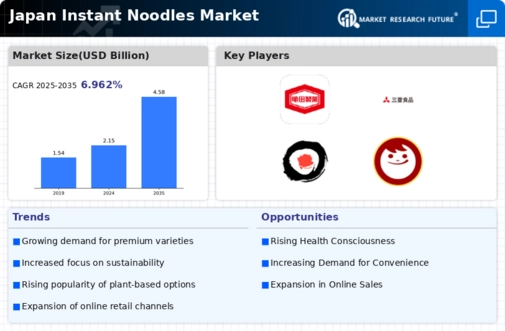Diverse Flavor Profiles
The instant noodles market in Japan is characterized by an impressive array of diverse flavor profiles that cater to local tastes and preferences. Japanese consumers exhibit a strong inclination towards unique and innovative flavors, which has led manufacturers to experiment with regional specialties and seasonal offerings. For instance, flavors such as tonkotsu, miso, and curry have gained popularity, appealing to a wide demographic. Market data indicates that flavor innovation contributes significantly to sales, with certain limited-edition flavors driving spikes in demand. This emphasis on variety not only enhances consumer experience but also encourages brand loyalty, as customers are often eager to try new flavors. As the market evolves, the continuous introduction of novel and exciting flavors is expected to play a crucial role in attracting consumers and sustaining growth in the instant noodles market.
Convenience and Time Efficiency
The instant noodles market in Japan thrives on the growing demand for convenience and time efficiency among consumers. With increasingly busy lifestyles, individuals seek quick meal solutions that require minimal preparation. Instant noodles provide a ready-to-eat option that can be prepared in just a few minutes, appealing to students, working professionals, and families alike. According to recent data, the instant noodles market in Japan has seen a growth rate of approximately 5% annually, driven by this need for convenience. The ability to enjoy a hot meal without extensive cooking aligns perfectly with the fast-paced nature of modern life, making instant noodles a staple in many households. This trend is likely to continue as more consumers prioritize convenience in their food choices, further solidifying the position of instant noodles in the market.
Affordability and Economic Factors
Affordability remains a key driver in the instant noodles market in Japan, particularly in the context of economic fluctuations. With rising living costs, consumers are increasingly seeking budget-friendly meal options that do not compromise on taste or quality. Instant noodles offer an economical solution, often priced at around ¥100 to ¥300 per serving, making them accessible to a broad audience. This price point is particularly appealing to students and low-income families, who may prioritize cost-effective meals. Additionally, the instant noodles market has shown resilience during economic downturns, as consumers tend to shift towards more affordable food options. The combination of affordability and convenience positions instant noodles as a favorable choice, suggesting that economic factors will continue to influence purchasing behavior in the market.
Cultural Integration and Tradition
The instant noodles market in Japan benefits from a deep cultural integration and tradition surrounding noodle consumption. Noodles have long been a staple in Japanese cuisine, and the introduction of instant noodles has seamlessly blended into this culinary landscape. The market reflects a unique fusion of traditional flavors and modern convenience, appealing to both older generations familiar with traditional noodle dishes and younger consumers seeking quick meal solutions. This cultural acceptance is evident in the popularity of instant noodles during festivals and family gatherings, where they are often enjoyed as a nostalgic comfort food. The enduring connection between instant noodles and Japanese culture suggests that this market will continue to thrive, as it resonates with consumers' culinary heritage while adapting to contemporary lifestyles.
Technological Advancements in Production
Technological advancements in production processes are significantly impacting the instant noodles market in Japan. Innovations in manufacturing techniques have led to improved product quality, shelf life, and flavor retention, enhancing the overall consumer experience. For instance, advancements in dehydration and packaging technologies allow for the preservation of freshness and taste, which is crucial in a competitive market. Additionally, automation in production lines has increased efficiency, enabling manufacturers to meet rising demand without compromising quality. Market analysis indicates that companies investing in technology are likely to gain a competitive edge, as consumers increasingly seek high-quality products. As these technological improvements continue to evolve, they are expected to play a pivotal role in shaping the future of the instant noodles market.















Leave a Comment